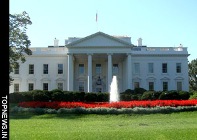The road to the White House passes through Ohio
 Youngstown, Ohio - In the first few nights with temperatures below freezing, the residents of the US state of Ohio are getting ready for a long winter with American football and bowling to distract them from the dreary weather.
Youngstown, Ohio - In the first few nights with temperatures below freezing, the residents of the US state of Ohio are getting ready for a long winter with American football and bowling to distract them from the dreary weather.
But every four years, the people of Ohio get to make a crucial decision before winter's onset: who will be the next president of the United States.
With a socio-economic mix and a strategic position between the East Coast and the rest of the country, the "Buckeye State" is unofficially the country's electoral barometer. Since 1964, whoever won Ohio also won the presidency.
This year is no different. The state holds 20 crucial electoral votes of the 270 needed to gain the White House, and with its loyalty swinging between the two major parties, Democrats and Republicans have been spending 7 million dollars a week here, local media report.
By October's end, Republican John McCain, 72, and his running mate, Alaska Governor Sarah Palin, will have visitedf 11 times. In the case of Democratic Senator Barack Obama, 47, his former rival Hillary Clinton - who carried Ohio in the primaries - has been at work on his behalf.
Opinion polls give Obama a lead of some 6 percentage points, evident in the adverts that bombard Ohioans. With just a week before the November 4 vote, McCain is fully on the offensive, describing a potential Obama administration as a "disaster" and a "tragedy."
Citizens listen, watch, think. Most have already made up their minds: Obama for change or McCain for experience. The class differences are evident, as Steven, a security guard at the General Motors plant in Lordstown, notes.
"My friends with money are for McCain, those without money are for Obama," he explains.
All worry about the state of the economy and, above all, unemployment figures. Ohio lost many jobs in the 2001 recession that did not come back, and its 7.2 per cent unemployment rate is one percentage point above the US average, and rising.
Ohio's prospects as the world heads into the biggest economic crisis since the Great Depression are even worse. Keith Ewald, head of the Ohio State Bureau of Labor Market Information, told Deutsche Presse-Agentur dpa that the greatest fears focus on the motor vehicle industry, and especially on struggling General Motors, Ford and Chrysler.
The Lordstown GM plant is "an oasis in the desert" around the nearby metropolis of Youngstown, says auto industry employee Matt Hardenbrook.
In the old days, the city of Youngstown, close to the Pennsylvania border, was the pride of the country's heavy industry. Now it is one of the best examples of how modern times hit the so-called Rust Belt - the industrial area from northern New York to Minnesota.
Blast furnaces closed shop or went bankrupt almost at once. In just over two decades, Youngstown went from 170,000 residents to 70,000. With the exception of a modern university, the city appears stuck in the 1980s. In its latest issue, the Rolling Stone magazine called it "the armpit of Ohio."
With a working-class majority, the Democrats lead.
"Absolutely, Obama. It just got ridiculous, everything is completely out of control, it's all about the big fat cats and nothing about the common man," Hardenbrook, 45, says angrily.
Paul Light, 59, another GM employee, says McCain is a "warmonger just like Bush is, he will keep our kids overseas fighting."
Jordan Klucinec, 35, the owner of a pub, says Obama would be "better for the American people than John McCain would be." He finds McCain's 72 years of age "a little concerning."
Chris Shoemaker, 54, an optometrist, may be making money using a Republican image by advertising "Sarah Palin" frames. But he likes Obama because he is "levelheaded, talks like a person, has a degree in law (and) grew up not having it easy."
He sees no conflict in his use of the Palin image.
"Look like a Republican but vote Democrat," he says with a smile and a shrug.
In other parts of the state, McCain has his supporters. In Geauga County, just outside Cleveland, Republicans have obtained 10 straight wins in presidential elections.
"I feel that I know what I'm going to get with (McCain). I feel I know more about him and I feel more comfortable about him," says Colleen Gast, 38, a physiotherapist. "I'm not sure what (Obama is) really out for."
Stan Penrad, 58, a sales representative who defines himself as "extremely conservative" and a "libertarian," charges Obama "doesn't have the experience."
"I don't like his ideas about big government, redistribution of other people's wealth. America was founded on the principle of seeking your own level," Penrad argues.
In the end, it's the undecided voters who will swing the state. And although there are not many (3-6 per cent of the Ohio electorate, according to opinion polls), they could change the result of the election.
"I'm not too happy with either candidate, says Jim Bloomster, 59, a lawyer. "I think Obama is naive, I think Mr McCain is unpredictable. That is not a good choice."
What is certain for Bloomster is that he will vote on November 4, because that's Ohio's role in any US presidential election.
New York may have sophistication and Los Angeles glamour, but the road to the White House passes through Ohio. dpa